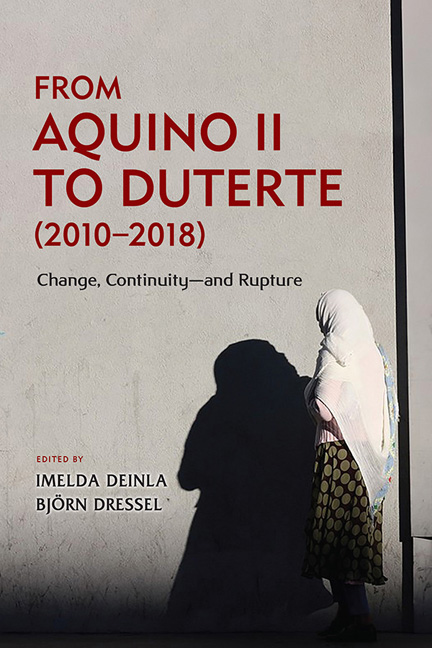Book contents
- Frontmatter
- Contents
- List of Tables
- List of Figures
- Acknowledgements
- Acronyms and Glossary
- Contributors
- Introduction: From Aquino II to Duterte (2010–2018): Change, Continuity—and Rupture 1
- PART I POLITICS AND GOVERNANCE
- PART II ECONOMIC GOVERNANCE
- 4 How Has the Economy Fared under the Duterte Administration So Far?
- 5 The Philippine Economy: Renewed Dynamism, Old Challenges
- 6 Competition Law and Policy in the Philippines: A Role in Sustained and Inclusive Economic Growth
- PART III PEACE PROCESS IN MINDANAO
- PART IV INTERNATIONAL ENVIRONMENT
- Index
5 - The Philippine Economy: Renewed Dynamism, Old Challenges
from PART II - ECONOMIC GOVERNANCE
Published online by Cambridge University Press: 31 January 2020
- Frontmatter
- Contents
- List of Tables
- List of Figures
- Acknowledgements
- Acronyms and Glossary
- Contributors
- Introduction: From Aquino II to Duterte (2010–2018): Change, Continuity—and Rupture 1
- PART I POLITICS AND GOVERNANCE
- PART II ECONOMIC GOVERNANCE
- 4 How Has the Economy Fared under the Duterte Administration So Far?
- 5 The Philippine Economy: Renewed Dynamism, Old Challenges
- 6 Competition Law and Policy in the Philippines: A Role in Sustained and Inclusive Economic Growth
- PART III PEACE PROCESS IN MINDANAO
- PART IV INTERNATIONAL ENVIRONMENT
- Index
Summary
INTRODUCTION
The transition from the second Aquino administration to the Duterte administration is a critical period in Philippine economic history. For most of the current decade, the Philippines has been one of the most dynamic economies in the world, growing at a rate not far short of the Asian giants, China and India, and a good deal faster than its traditional neighbouring comparator, Thailand. The Philippines appears to have discarded its “sick man of Asia” epithet. The record is all the more notable for having occurred in the aftermath of the global financial crisis, and during an era characterized by slow global growth and considerable financial volatility.
However, earlier periods of economic dynamism have not been sustained. The Philippines has a history of boom and bust economic cycles, in which periods of economic growth are followed by a crisis, or at least a major growth slowdown. The question is, will this time be different? The current growth acceleration broadly coincides with the 2010–16 Aquino administration. Yet, in spite of the current political controversies, the economic dynamism continued into the first eighteen months of the Duterte administration.
It is premature to pass judgement on the Duterte administration's economic record. This chapter therefore provides an analytical narrative of the drivers and outcomes of the Philippine's recent economic performance. Some of the key development challenges will be explored, including the importance of maintaining macroeconomic stability—and, by extension, crisis avoidance—and constructing a more inclusive growth path.
Section 2 provides an economic survey, including growth, structural change and macroeconomic management. Section 3 then investigates some key development issues and challenges—including the business process outsourcing (BPO) success story, overseas employment, regional (subnational) dynamics, living standards, and institutional development. Section 4 sums up.
Where relevant, we compare and contrast the recent Philippine economic record with its middle-income neighbours—Indonesia, Thailand and Vietnam. Historically, Thailand was the most frequently used comparator. Around 1960 Philippine per capita income was about double that of Thailand. By the mid-1990s, the relativities had been reversed owing to Thailand's faster growth and the Philippines’ “lost decade” of the 1980s.
- Type
- Chapter
- Information
- From Aquino II to Duterte (2010–2018)Change, Continuity—and Rupture, pp. 145 - 185Publisher: ISEAS–Yusof Ishak InstitutePrint publication year: 2019

